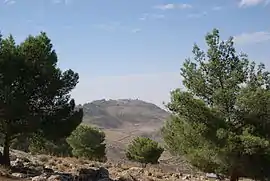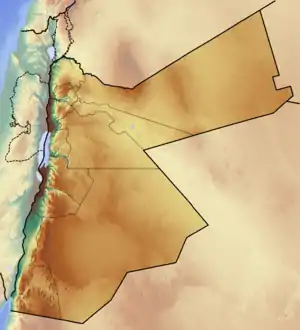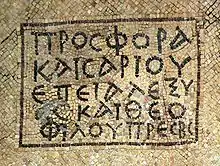Mount Nebo
Mount Nebo (Arabic: جَبَل نِيْبُو, romanized: Jabal Nībū; Hebrew: הַר נְבוֹ, romanized: Har Nevo) is an elevated ridge of the Abarim in Jordan, approximately 710 metres (2,330 ft) above sea level. It is mentioned in the Hebrew Bible as the place where Moses was granted a view of the Promised Land. The view from the summit provides a panorama of the land and, to the north, a more limited one of the valley of the River Jordan. The West Bank city of Jericho is usually visible from the summit, as is Jerusalem on a very clear day.
| Mount Nebo | |
|---|---|
| جَبَل نِيْبُو הַר נְבוֹ | |
 Mount Nebo seen from the east | |
| Highest point | |
| Elevation | 808 m (2,651 ft) |
| Coordinates | 31°46.0′N 35°43.5′E |
| Naming | |
| Native name | جَبَل نِيْبُو |
| Geography | |
 Mount Nebo Location | |
| Location | Jordan |
| Region | Madaba Governorate |
Religious significance
According to the final chapter of the Book of Deuteronomy, Moses ascended Mount Nebo to view the Land of Canaan, which God had said he would not enter; he died in Moab.[1]
According to Christian tradition, Moses was buried on the mountain, although his place of burial is not specified (Deuteronomy 34:6). Some Islamic traditions also stated the same,[2] although there is a grave of Moses located at Maqam El-Nabi Musa, 11 km (6.8 mi) south of Jericho and 20 km (12 mi) east of Jerusalem in the Judean wilderness.[3] Scholars continue to dispute whether the mountain currently known as Nebo is the same as the mountain referred to in Deuteronomy.
According to 2 Maccabees (2:4–7), the prophet Jeremiah hid the tabernacle and the Ark of the Covenant in a cave there.
On March 20, 2000, Pope John Paul II visited the site during his pilgrimage to the Holy Land.[4] During his visit he planted an olive tree beside the Byzantine chapel as a symbol of peace.[5] Pope Benedict XVI visited the site in 2009, gave a speech, and looked out from the top of the mountain in the direction of Jerusalem.[6]
A serpentine cross sculpture (the Brazen Serpent Monument) atop Mount Nebo was created by Italian artist Giovanni Fantoni. It is symbolic of the bronze serpent created by Moses in the wilderness (Numbers 21:4–9) and the cross upon which Jesus was crucified (John 3:14).
Archaeology
Systematic exploration begun by Sylvester J. Saller O.F.M. were continued in 1933 by Jerome Mihaic of the Studium Biblicum Franciscanum. On the highest point of the mountain, Syagha,[7] the remains of a Byzantine church[8] and monastery were discovered in 1933.[9] The church was first constructed in the second half of the 4th century to commemorate the place of Moses' death. The church design follows a typical basilica pattern. It was enlarged in the late fifth century AD and rebuilt in AD 597. The church is first mentioned in an account of a pilgrimage made by a lady Aetheria in AD 394. Six tombs have been found hollowed from the natural rock beneath the mosaic-covered floor of the church.
Bellarmino Bagatti worked on the site in 1935. Virgilio Canio Corbo later excavated the interior of the basilica. In 1963, he was put in charge of restoring the original pavements for exhibition. [10] In the modern chapel presbytery, built to protect the site and provide worship space, remnants of mosaic floors from different periods can be seen. The earliest of these is a panel with a braided cross presently placed on the east end of the south wall.
The Moses Memorial that houses the Byzantine mosaics was closed for renovation from 2007 to 2016. It reopened on 15 October 2016.[11][12][13]
Gallery
.jpg.webp) Stone at the entrance of the mount.
Stone at the entrance of the mount. Stone marking the entrance to historic Mount Nebo
Stone marking the entrance to historic Mount Nebo Plaque showing the distance from Mount Nebo to various locations
Plaque showing the distance from Mount Nebo to various locations Structure protecting excavated remains of a church
Structure protecting excavated remains of a church The mosaic in the Diakonikon baptistery
The mosaic in the Diakonikon baptistery Baptismal Font
Baptismal Font Mosaic inscription inside (Offering of Caesarion, at the time of Alexios and Theophilos priests)
Mosaic inscription inside (Offering of Caesarion, at the time of Alexios and Theophilos priests) The Brazen Serpent sculpture, Mount Nebo.
The Brazen Serpent sculpture, Mount Nebo. Detail of Brazen Serpent statue
Detail of Brazen Serpent statue Mosaic details from the Theotokos chapel[14]
Mosaic details from the Theotokos chapel[14].jpg.webp) Nebo Mountain
Nebo Mountain.jpg.webp) Nebo Mountain
Nebo Mountain.jpg.webp) Mosaics, Nebo Mountain
Mosaics, Nebo Mountain.jpg.webp) Mosaics, Nebo Mountain
Mosaics, Nebo Mountain.jpg.webp) Mosaics, Nebo Mountain
Mosaics, Nebo Mountain.jpg.webp) Mosaics, Nebo Mountain
Mosaics, Nebo Mountain
References
- Deuteronomy 34:1–6
- Islamic sites in Jordan Archived 2013-11-10 at the Wayback Machine
- Amelia Thomas; Michael Kohn; Miriam Raphael; Dan Savery Raz (2010). Israël & the Palestinian Territories. Lonely Planet. pp. 319. ISBN 9781741044560.
- Pope speaks of 'inseparable' bond between Christians, Jews
- Piccirillo, Michele (2009). Mount Nebo (Studium Biblicum Franciscanum Guide Books, 2) p. 107.
- http://www.catholicnewsagency.com/news/pope_benedict_begins_his_pilgrimage_on_mt._nebo/
- Also found as "Siyagha" the peak is (710 metres), while the south eastern peak "el-Mukhayyat" is 790 metres. Piccirillo, Michele (2009). Mount Nebo. p. 17.
- "Complete compendium of Mount Nebo". Madain Project. Retrieved 2 April 2018.
- Piccirillo, Michele (2009) Mount Nebo (Studium Biblicum Franciscanum Guide Books, 2) pp. 14–15. Extract from Sylvester Saller The Memorial of Moses on Mount Nebo Jerusalem 1941, pp. 15–18.
- "Chronology of Mount Nebo". Madain Project. Retrieved 2 April 2018.
- "Moses Memorial Church". Madain Project. Retrieved 2 April 2018.
- http://www.en.abouna.org/en/holylands/memorial-moses-mount-nebo-reopened
- http://www.jordantimes.com/news/local/moses-memorial-reopens-mount-nebo-after-10-years-renovation
- "Theotokos Chapel (Mount Nebo)". Archived from the original on 13 April 2020.
Further reading
- Mount Nebo: New Archaeological Excavations: 1967–1997, Michele Piccirillo and Eugenio Alliata
External links
| Wikimedia Commons has media related to Mount Nebo. |
- Franciscans at Mount Nebo
- Archaeology and Art – photographs of excavations in Jordan
- Pictures from mount Nebo 1
- . New International Encyclopedia. 1905.